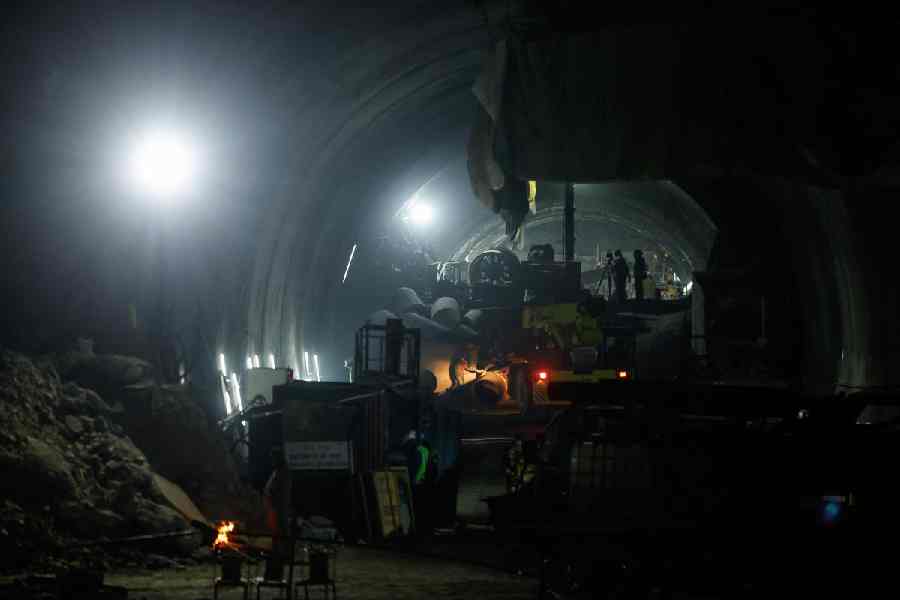Rescuers began drilling into the hill above the Silkyara-Barkot tunnel Sunday, boring nearly 20 metres on the first day of adopting the new approach to reach 41 workers trapped inside for 14 days.
The vertical approach was one of the at least five options on which preparatory work had begun some days back, as anxiety mounted over the fate of the men trapped in the under-construction tunnel on Uttarakhand’s Char Dham route.
Rescue workers have to drill down 86 metres to reach the tunnel. By evening, the heavy drilling equipment had bored down to about 19.5 metres.
National Highways and Infrastructure Development Corporation Limited (NHIDCL) managing director Mahmood Ahmed said vertical boring would be over by Thursday if there are no hurdles.
As the drilling progresses, 700-mm wide pipes are being inserted to create an escape passage. A little distance away, a thinner, 200-mm probe is being pushed in. It has reached the 70-metre mark.
The vertical boring option was picked as the next best alternative after the latest in a series of snags that hit the horizontal drilling operation from the tunnel’s Silkyara-end, where an estimated 60-metre stretch of rubble faced rescue workers.
This portion of the tunnel collapsed on Diwali morning, cutting off the exit of the workers inside.
A huge auger drill – a corkscrew like-device with a rotary blade at the front-end – that is drilling into this stretch of debris got stuck Friday evening, forcing officials to give up on the 25-tonne machine.
Individual workers have been entering this incomplete escape passage – in which a steel chute has been inserted – to cut through and bring out the stuck blades and the auger's shaft in pieces.
On Saturday morning, a plasma cutter was airlifted from Hyderabad to supplement the gas cutter. A Defence Research and Development Organisation (DRDO) team and a unit of Army engineers, the Madras Sappers, also reached Silkyara.
By Sunday evening, only 8.15 metres of the auger shaft – of the 47 metres altogether – remained to be cut out, officials said.
“The exercise may be completed by Sunday midnight or tomorrow morning," Khairwal had predicted earlier in the day.
Once the auger is completely extricated, rescuers will adopt another fresh approach -– manual drilling to clear the remaining 10 or 12 metre stretch of rubble.
One worker will enter the steel chute laid so far and operate the drill, and another man will send the debris up through a pulley in the time-consuming operation to be carried out in confined space.
Meanwhile, work on other options is also in progress, officials said.
From Tuesday, rescue workers will start drilling a 180-metre alternative escape tunnel into the side of the hill. This could take 12-14 days.
Officials said drilling is also being carried out from the Barkot-end of the tunnel, and workers have progresses about 10 out of 483 metres.
Asked about the absence of an escape tunnel that some say should have been constructed at an earlier stage of the Silkyara-Barkot project, NHIDCL MD Ahmed said he had also thought about this aspect.
“A committee has been set up to go into all that. But as of now our first priority is the safe evacuation of the trapped workers as early as possible," he said.
The NHIDCL was executing the project through Navayuga Engineers Pvt Ltd.
The trapped workers are in a built-up two-kilometre stretch of the tunnel. They are being sent food, medicines and other essentials through a six-inch wide pipe.
A communication system has also been set up and families occasionally talk to them.
At his media briefing in Delhi, NDMA member Lt Gen (retd) Ata Syed Hasnain said the best option remained horizontal drilling under which 47 metres of rubble has already been bored through.
Relatives of those trapped inside remained anxious after drilling with the auger machine was abandoned.
"Once he comes out, we will never allow him to work here again," Manjeet’s father Chowdhury said. The Uttar Pradesh farm labourer lost a son in an accident earlier in Mumbai.
Chowdhury spoke to his son through the communication link on Sunday.
"My son looked fine. I am a bit stressed though due to the delay in the rescue work. Today, I told him that this is a war but he should not be scared. We will succeed soon.” The administration has set up a camp for the families of the trapped workers outside the tunnel. They talk daily with the men inside.
Except for the headline, this story has not been edited by The Telegraph Online staff and has been published from a syndicated feed.











